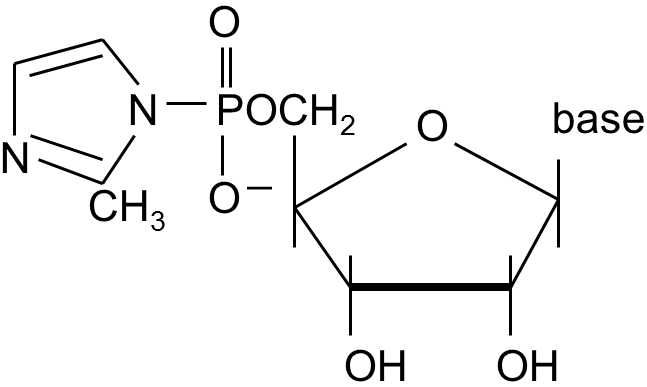X.3.2 Systems containing nucleic acids, but not proteins, could have been present at the beginning
This hypothesis apparently has the most advocates at the present time.This is also sometimes termed the gene hypothesis of the origin of life.The hypothesis assumes that the original structure that was already capable of biological evolution could have been a nucleic acid or a chemically similar substance (Kolb, Dworkin, & Miller 1994; Miller 1997; Nelson, Levy, & Miller 2000; Orgel 2000). This nucleic acid apparently did not originally have any metabolic activity and also did not have any information for synthesis of proteins or other compounds, but was capable of self-replication under suitable conditions.The best-known variant of the gene hypothesis of the origin of life assumes that the original polymer was RNA (Hirao & Ellington 1995; James & Ellington 1995; Hager, Pollard, & Szostak 1996).Consequently, this hypothesis is frequently termed the RNA world hypothesis (Gilbert 1986).
Non-enzymatic synthesis of the complementary nucleic acid chain is very ineffective but, at the very least, possible in principle (Orgel 1992; Joyce 1984; Kanavarioti 1994)(Fig. X.6).It can be imagined that, in an environment containing a sufficient number of precursors (activated nucleotides), in which periodic temperature changes also occurred, a cycle of replication of oligonucleotides (short nucleic acid segments) could have emerged.At high temperatures, the double-helix oligonucleotide molecules could have been denatured to form the individual helixes; at low temperatures, the complementary nucleotide settled on these helixes and combined covalently, through a momentarily unclear mechanism, to form a new helix that was complementary to the original helix.Following repeated increase and decrease in temperature, the entire cycle of denaturation and replication of the oligonucleotides was repeated.

Fig. X.6. Nonenzymatic replication of a nucleic acid. Suitably activated monomers of nucleic acids can spontaneously specifically fit to a complementary nucleotide of the polynucleotide chain and subsequently create a linear polymer without participation by any enzyme at all. The scheme depicts the formula of mononucleotid-5’-phospho-2-methylimidizole, i.e. a compound that is capable of acting as a nucleic acid precursor. However, in this case, it is necessary that the first chain (template) contain a substantial predominance of cystine. According to Joyce (1984).
The synthesis of complementary chains without participation of enzymes is undoubtedly a very ineffective, imprecise and slow process.However, it can be justifiably expected that its effectiveness depends to a certain degree on the sequence of replicated oligonucleotides.The oligonucleotides of a certain sequence replicated faster so that they logically predominated in the environment after some time.Because of the lack of precision in non-enzymatic replication, new types of oligonucleotides were formed, differing from the original ones in the substitution of some nucleotides.Some of the new oligonucleotides were again capable of replicating faster than their predecessors, so that the oligonucleotides could gradually evolve towards increasingly fast and effective replication.
It is not difficult to imagine that the secondary or tertiary structures of some oligonucleotides could exhibit affinity for certain molecules located in the environment, for example, for some proteinoids, and that their interactions with these molecules could be in some way advantageous from the viewpoint of the autoreplication cycle.For example, the bonding of the proteinoid or a peptide to the oligonucleotide could change the density of the complex and, as a consequence of this change, the complex could be relocated to a different place in the environment, for example, to a place with high temperature.This could lead to its denaturation and dissociation into two complementary chains and the proteinoid.This again changed the density of the chains and they returned to the colder areas, where their self-replication could occur and, in time, also association with new proteinoid molecules.An oligonucleotide with affinity for a proteinoid thus attained a certain degree of independence on temperature changes in the environment, providing it with a clear advantage over its competitors, i.e. the other oligonucleotides.
